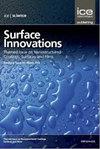Preparation of self-healing polythiourethane/epoxy anticorrosive coatings based on dynamic disulfide bonds
IF 2.7
4区 材料科学
Q3 CHEMISTRY, PHYSICAL
引用次数: 0
Abstract
Defects and mechanical damage that leading to peeling, corrosion, and other potential hazards during practical applications were inevitable in epoxy coatings due to the high cross-link density of the epoxy network. Herein, we synthesized a self-healing polythiourethane material (SPTU) containing with dynamic disulfide bonds for the design and preparation of a self-healing SPTU/epoxy coating. FT-IR, 1H NMR and SEM showed that 2-hydroxyethyl disulfide was successfully introduced into the polythiourethane system. Due to the fracture and reattach of double sulfur bond, 3% SPTU-Epoxy coating exhibited good self-healing properties in scratch-treated, the scratch being repaired completely after 2 h at 85°C. Meanwhile, the tensile properties of the completely fractured 3% SPTU-Epoxy sample retained 75.7% after self-healing. The Tafel polarization crurve and electrochemical impedance spectroscopy (EIS) results demonstrate the 3% SPTU-Epoxy coating showed excellent corrosion resistance and still provides considerable corrosion resistance after 19 days of immersion corrosion tests. The self-healing coating exhibited good self-healing ability under heating conditions attributed to the bond breaking and reconnection of dynamic bonds provided by the self-healing component. The self-healing property and corrosion resistance of the prepared coating effectively improve the service life of the epoxy coating and provide some guidance for corrosion protection of epoxy coating.基于动态二硫键的自修复聚硫氨基甲酸酯/环氧防腐涂料的制备
由于环氧树脂网络的高交联密度,在实际应用中不可避免地会出现导致剥落、腐蚀和其他潜在危害的缺陷和机械损伤。在此,我们合成了一种含有动态二硫键的自修复聚硫聚氨酯材料(SPTU),用于设计和制备自修复SPTU/环氧涂料。红外光谱(FT-IR)、核磁共振氢谱(1H NMR)和扫描电镜(SEM)表明,2-羟乙基二硫醚被成功引入聚硫脲体系。由于双硫键的断裂和再附着,3% sptu -环氧涂层在划痕处理中表现出良好的自修复性能,在85℃下加热2 h即可完全修复划痕。同时,完全断裂的3% sptu -环氧树脂试样自愈后拉伸性能仍保持75.7%。Tafel极化曲线和电化学阻抗谱(EIS)结果表明,3% sptu -环氧树脂涂层具有优异的耐腐蚀性,并且在19天的浸泡腐蚀试验后仍具有相当的耐腐蚀性。自修复涂层在加热条件下表现出良好的自修复能力,这是由于自修复组分提供的键断裂和动态键的重新连接。所制备涂层的自愈性和耐腐蚀性有效地提高了环氧涂层的使用寿命,为环氧涂层的防腐提供了一定的指导。
本文章由计算机程序翻译,如有差异,请以英文原文为准。
求助全文
约1分钟内获得全文
求助全文
来源期刊

Surface Innovations
CHEMISTRY, PHYSICALMATERIALS SCIENCE, COAT-MATERIALS SCIENCE, COATINGS & FILMS
CiteScore
5.80
自引率
22.90%
发文量
66
期刊介绍:
The material innovations on surfaces, combined with understanding and manipulation of physics and chemistry of functional surfaces and coatings, have exploded in the past decade at an incredibly rapid pace.
Superhydrophobicity, superhydrophlicity, self-cleaning, self-healing, anti-fouling, anti-bacterial, etc., have become important fundamental topics of surface science research community driven by curiosity of physics, chemistry, and biology of interaction phenomenon at surfaces and their enormous potential in practical applications. Materials having controlled-functionality surfaces and coatings are important to the manufacturing of new products for environmental control, liquid manipulation, nanotechnological advances, biomedical engineering, pharmacy, biotechnology, and many others, and are part of the most promising technological innovations of the twenty-first century.
 求助内容:
求助内容: 应助结果提醒方式:
应助结果提醒方式:


